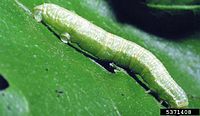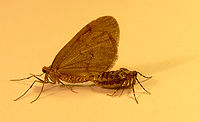- Winter Moth
-
- In North America, "Winter Moth" usually denotes the closely related Operophtera bruceata, but may also mean the less close relative Erannis tiliaria (Linden Looper).
Winter Moth 
Scientific classification Kingdom: Animalia Phylum: Arthropoda Class: Insecta Order: Lepidoptera Family: Geometridae Genus: Operophtera Species: O. brumata Binomial name Operophtera brumata
Linnaeus, 1758The Winter Moth (Operophtera brumata) is a moth of the family Geometridae. It is an abundant species of Europe and the Near East and one of very few Lepidoptera of temperate regions in which the adults are active in the depth of winter.
The female of this species is virtually wingless and cannot fly, but the male is fully winged and flies strongly. Its wingspan is 28–33 mm with alternating pale buff and darker brown fascia on the forewings and a similar pattern, but much paler, on the hindwings. The adults are active at night throughout the winter from October to February[1]. Males are attracted to light and females.
After mating, females lay their eggs in tree bark crevices or in other sheltered locations, and all adults die. The eggs hatch in the spring when temperatures average around 13°C (55°F). After hatching, the young larvae crawl up tree trunks and produce silken thread that can carry them in the wind to new areas. This dispersal method, called "ballooning," is common among defoliators.
The caterpillars are green loopers with pale lines on the sides and a darker one along the top. They will feed on virtually any tree or shrub (see list below) and can be a serious pest in apple orchards. Generally, their feeding is completed by mid-June.
Winter Moths are considered an invasive species in North America; Nova Scotia experienced the first confirmed infestations in the 1930s. The moth is now found in British Columbia, Washington, Oregon, New Brunswick, Prince Edward Island, and Massachusetts. In Massachusetts, the moths have attracted the attention of several media outlets due to the severity of the infestation.[1] There have been unconfirmed reports of infestations in southern New Hampshire and northern Rhode Island.
Recorded food plants
- Acer - Maple
- Amelanchier
- Betula - Birch
- Calluna - Heather
- Carpinus - European Hornbeam
- Castanea - Chestnut
- Corylus - Hazel
- Cotoneaster
- Crataegus - Hawthorn
- Cydonia - Quince
- Fagus - Beech
- Fraxinus - Ash
- Larix - European Larch
- Malus - Apple
- Myrica
- Ostrya
- Picea - Norway Spruce
- Populus - Poplar
- Prunus
- Pyrus - Pear
- Quercus - Oak
- Rhamnus - Buckthorn
- Rhododendron
- Ribes - Currant
- Rosa - Rugosa Rose
- Rubus - Raspberry
- Salix - Willow
- Sorbus
- Tilia - Lime
- Ulmus - Elm
- Viburnum
References
- Chinery, Michael, Collins Guide to the Insects of Britain and Western Europe, 1986 (Reprinted 1991)
- Skinner, Bernard, Colour Identification Guide to Moths of the British Isles, 1984
- The pest control of the chestnut tree by Dr Péter Szentiványi. Chestnut - Agricultural Publisher. For Sarkpont Cc., Hungary.
- ^ "Mystery pests" Boston Globe (12/3/09) http://www.boston.com/news/local/articles/2009/12/03/invasion_of_winter_moths_has_scientists_residents_looking_for_answers/
Notes
- ^ The flight season refers to the British Isles. This may vary in other parts of the range.
Categories:- Operophtera
- Agricultural pest insects
- Insect pests of temperate forests
- Invasive animal species
- Animals described in 1758
Wikimedia Foundation. 2010.




